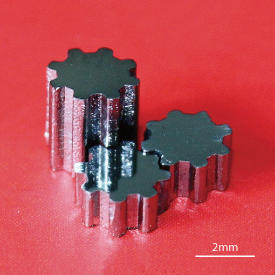

10/28/2019

Reprinted by permission from Nature: Nature (Ref. 1), copyright (2019).
A rapid approach for making and testing metallic glasses has been developed by AIMR researchers1. This method promises to greatly speed up the search for optimized metallic glasses.
First discovered in 1960, metallic glasses are metal alloys that have an amorphous, glass-like structure rather than a crystalline structure like conventional alloys. They have many useful properties, including high processability, high strength, and resistance to wear and corrosion.
For metallic glasses to be useful for applications such as electronic components and biomedical implants they need to maintain this glass-like state over a wide temperature range. "Generally, metallic glass with a wide supercooled liquid region can be fabricated into large samples and easily shaped into different structures, which is good for commercial applications,” explains Zhen Lu of the AIMR at Tohoku University. They also need a high glass-transition temperature — the point at which they change from a glass to a supercooled liquid — to ensure that they have a good thermal stability and a high stiffness. However, finding metallic glasses that satisfy these two criteria through trial and error is painstakingly slow.
Now, Lu and collaborators at the Institute of Physics (Chinese Academy of Sciences) and other institutions in China and the United States have come up with a fast method for making and measuring metallic alloys made up of different proportions of three metals, and have used it to find a metallic glass with a high glass-transition temperature of 1,162 kelvin.
The team sputtered three metals — iridium, nickel and tantalum — onto a substrate, the proportions of which varied continuously with position on the substrate. They then measured the electrical resistivity at different points on the substrate. As resistivity correlates to glass-forming ability, the researchers were able to quickly and easily identify regions where metallic glasses had formed. They also tested the mechanical properties at different substrate locations.
"By combining a high-throughput fabrication method such as magnetron co-sputtering with high-throughput measurements, we can explore a library of samples containing hundreds of components and properties in just a few days,” says Lu. "This approach promises to greatly accelerate the development rate and extend the exploration range of new materials.”
The method is straightforward to implement. "Unlike previous approaches, it can be directly used for many glass-forming systems,” says Lu. "It costs about US$3,000 to build the apparatus we used for mapping electrical resistance, making it feasible and affordable for many laboratories that lack access to a synchrotron.”
The team wants to apply their method to other metal combinations. "We plan to use these high-throughput combinatorial methods to explore new libraries of metallic glasses and extend the applications of metallic glasses,” says Lu.
This research highlight has been approved by the authors of the original article and all information and data contained within has been provided by said authors.